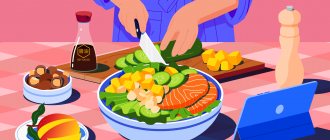Constipation or coprostasis is a delay in bowel movement for more than two days. In another interpretation, it includes the daily excretion of feces, but in a very small volume (less than 100 g).
It is rare for an adult to experience such a frequency of stool without unpleasant or painful sensations or a general disturbance of well-being. The problem arises of how to eat with constipation if the intestines are clogged. Questions about proper nutrition are increasingly of interest to residents of developed countries, wealthy people who have the opportunity to choose products.
According to statistics, they prefer fatty foods, sweet drinks, a lot of coffee, do not pay attention to the presence of fiber in vegetables and fruits in their diet, are addicted to fashionable diets, and do not exercise much. A diet for constipation is formed after identifying the causes and excluding the influence of diseases with pathology of the digestive organs.
What diseases cause constipation?
The bolus of food moves through the intestines due to contractions of the muscle layer. The colon is of particular importance in the formation and removal of waste from the body. With the help of wave-like contractions (peristalsis), it ensures motility and movement of feces into the rectum.
Violation of this function is possible in a spastic or atonic type:
- During spasm, peristalsis is enhanced, muscle tone is increased, areas with a narrowed lumen appear, up to the development of intestinal obstruction. Clinically, it manifests itself as severe abdominal pain, vomiting, and uneven bloating. In such cases, food is prohibited and urgent surgical measures are necessary.
- Atonic coprostasis - is caused more often in older people due to the lack of “response” of the intestinal muscles to stimulating signals coming along the nerve trunks. The intestines lose their ability to contract.
The type of constipation can be suspected by symptoms
Constipation occurs as one of the serious symptoms of intestinal lesions due to inflammation (colitis), pain due to hemorrhoids, rectal fissures, proctitis, diseases of the stomach, liver and gallbladder, congenital anomalies (dolichosigma, megasigma).
If the examination reveals a disease, then a diet for constipation in adults is considered as one of the components of therapy. Patients must take into account the requirements for compliance with the use of foods that weaken the intestines no less seriously than taking laxatives and other drugs.
FAQ
How does an anti-constipation diet affect your health?
In addition to solving the main issue, it helps to get rid of accompanying symptoms: bloating, abdominal pain. In addition, it normalizes the functioning of the gastrointestinal tract, prevents the development of intoxication and diseases that contribute to constipation (gastritis, cholecystitis), and normalizes intestinal microflora.
By following a dietary diet, the condition of hair and skin improves, weight decreases, and the body receives the necessary amount of vitamins and minerals.
What are the consequences of irregular bowel movements?
Irregular bowel movements are dangerous due to the following complications:
- diseases of the rectum (paraproctitis, fissures, hemorrhoids);
- malignant tumors;
- chronic inflammation of the colon;
- secondary colitis;
- megacolon (elongation or expansion of the intestine);
- proctosigmoiditis;
- intestinal obstruction.
Prolonged stagnation of contents in the cecum increases the risk of backflow into the small intestine (reflux enteritis). Constipation leads to the formation of carcinogenic substances that aggressively affect the walls of the organ. As a result, the person feels unwell, loses weight before our eyes, and goes to the toilet with blood. These alarming symptoms suggest the occurrence of a colon tumor.
How does an active lifestyle affect constipation?
Intense motor mode (running, swimming, hiking and skiing, physical activity) stimulates intestinal activity, increases body tone, strengthens abdominal muscles, and normalizes the neuropsychic background.
What should a doctor find out before prescribing a diet?
In the absence of any pathology in the patient, it is important to find out the type of diet, preferences, regularity and frequency of meals. The fact is that intestinal peristalsis is subject to functional disruptions in the case of irregular nutrition, dry snacks like sandwiches and hamburgers without first courses, long periods of hunger followed by overeating.
Coprostasis is caused by inappropriate choice of foods and dishes. A significant amount of fats and proteins (fatty meat, confectionery), light carbohydrates (sweets) slow down the digestion of food starting from the stomach. A small amount of raw vegetables, fruits, fiber (dietary bread made from wholemeal flour, bran, cereals), lack of drinking water do not include substances that stimulate peristalsis in the digestion process.
The reflex mechanism of urges is disrupted by frequent restraint in the absence of a toilet nearby, a “sedentary” lifestyle, and fasting for weight loss and cleansing. Constipation with a diet of this kind is associated with a change in the contents of the intestines, feces acquire a hard, rocky consistency, and its elimination is difficult.
Sometimes the doctor finds out the influence of stress, pregnancy in women, low adaptability to a new environment, these reasons aggravate stagnation of feces and can subsequently lead to serious illnesses
Standard table No. 3 and its purpose
Diet No. 3 (according to Pevzner) is recommended for patients with diseases or physiological conditions accompanied by constipation. It is indicated for people with a lack of physical activity, with forced long-term bed rest, if the disturbances are caused by climate change, moving, or pregnancy.
It is important to consider that against the background of exacerbation of chronic diseases of the stomach and intestines, you cannot use diet No. 3 for constipation. It includes many irritating factors, which will have a harmful effect on the inflamed organs. Diet objectives:
- strengthen peristaltic contractions of the intestine;
- balance the effects of bile acids;
- “extinguish” the processes of fermentation and decay.
The patient should have regular bowel movements and bloating should disappear. General table rule No. 3 is to eat less than three kg of food per day, drink 1.5 liters of water or more (if there are no restrictions due to the condition of the kidneys or the cardiovascular system). Eating for constipation in adults does not require mechanical grinding of food.
You can eat five times a day, the frequency should be distributed approximately every 4 hours. This is important for bowel function. A positive aspect of the table is the general availability of products, the opportunity for patients with average incomes to fulfill the requirements for a long time with effective results, and individually choose the most suitable ones.
Some nutritionists consider the contraindication of milk to be a disadvantage. Others consider compensation through fermented milk products to be quite sufficient. There are no restrictions on the amount of protein, fat and carbohydrates required. Calorie intake on some days can be reduced for obese patients in consultation with the doctor.
It is recommended to train yourself to drink half a glass of water 30 minutes before meals and an hour after
Survey
A gastroenterologist is involved in finding out the causes of constipation in the elderly. A diagnostic search involves a comprehensive examination of the gastrointestinal tract, which is aimed at studying the morphological features and functionality of the digestive system. If necessary, consultations with other specialists are prescribed. The most informative are:
- Rectal examination
. A digital examination of the rectum is performed to study the structure of the mucous membrane, identify enlarged hemorrhoids, cracks and space-occupying formations. According to indications, the examination is supplemented with anoscopy or sigmoidoscopy to visualize the lower parts of the large intestine. - Endoscopy
. Colonoscopy is prescribed to all elderly people with complaints of delayed bowel movements for a detailed study of the structure of the colon and sigmoid colon, and to identify tumors. If suspicious areas are detected, a biopsy is performed for further histological analysis. - X-ray examination
. Taking X-rays after oral contrasting of the gastrointestinal tract with barium sulfate is necessary to detect organic changes in the intestinal wall, signs of ulcerative defects, and inflammatory processes. Delayed images are taken to determine the rate of passage of chyme through the intestines. - Sonography.
Using abdominal ultrasound, the structural and functional features of the digestive tract are assessed and pathological changes that can cause constipation are identified. If necessary, an ultrasound of large vessels of the abdominal cavity is performed to exclude occlusion of the mesenteric arteries. - Stool tests
. Constipation in the elderly is accompanied by changes in the consistency and composition of stool, which is established using a coprogram. To study the microflora of the large intestine, bacteriological analysis is carried out. The Gregersen reaction to occult blood helps to exclude chronic bleeding from the gastrointestinal tract.
To clarify the diagnosis and detailed visualization of the structures of the abdominal cavity, computed tomography is prescribed. All patients undergo general and biochemical blood tests. If damage to the intestinal vasculature is suspected, contrast angiography is performed. To exclude diseases of the hepatobiliary system, duodenal intubation with microscopic and bacteriological examination of bile is used.
If you are prone to constipation, you should reconsider your diet
What not to eat if you are constipated
For constipation, foods containing quickly digestible substances that do not have nutritional value and fiber are excluded or sharply limited from the menu. These include:
- any rich pastries, fresh wheat bread, products with cream, types of pasta;
- dishes from canned food, fatty fish and meat, smoked meats, spicy sausages;
- whole milk, cream, full-fat sour cream and cottage cheese;
- cereals - semolina, rice, lentils, beans, peas;
- fried foods (fried eggs);
- fatty and spicy sauces, mayonnaise;
- vegetables - onions, radishes, garlic, radishes in any form;
- mushrooms;
- chocolate, sweets and culinary products containing chocolate;
- berries - blueberries, quince, dogwood and jam from them;
- persimmon fruits, pomegranate, bananas;
- drinks - restrictions apply to coffee, cocoa, strong tea, carbonated water, alcohol, jelly.
Prohibitions apply to:
- puff pastry baked goods;
- dishes from fatty poultry (duck);
- lard;
- fatty fish (herring products, salmon, silver carp, mackerel);
- cottage cheese with a fat content of over 9%, cheese - 45%;
- hot seasonings (mustard, pepper, vinegar, horseradish).
Fully or partially limited products
- Chocolate and any products with cream are not allowed. It is worth excluding bread made from premium flour, as well as baked goods made from yeast dough and puff pastry.
- Dishes containing tannins are excluded - these are jelly from quince, pears, bird cherry, blueberry, dogwood, strong tea, cocoa and coffee.
- Dishes that have a viscous consistency and move slowly through the intestines are slimy soups, mashed potatoes, mashed porridges and jelly.
- Difficult to digest and remain in the stomach for a long time are fatty types of meat (duck, goose) and fish, canned food, smoked meats, and hard-boiled eggs. They must be excluded from the diet.
- Spicy dishes, sauces, horseradish and mustard greatly irritate the mucous membrane and disrupt the function of the entire gastrointestinal tract.
- You should limit foods that initially cause constipation - rice, semolina, noodles, sago, vermicelli, potatoes, as well as legumes, which may be poorly tolerated.
Table of prohibited products
| Proteins, g | Fats, g | Carbohydrates, g | Calories, kcal | |
Vegetables and greens | ||||
| potato | 2,0 | 0,4 | 18,1 | 80 |
| radish | 1,2 | 0,1 | 3,4 | 19 |
| white radish | 1,4 | 0,0 | 4,1 | 21 |
| turnip | 1,5 | 0,1 | 6,2 | 30 |
| horseradish | 3,2 | 0,4 | 10,5 | 56 |
| garlic | 6,5 | 0,5 | 29,9 | 143 |
Fruits | ||||
| quince | 0,6 | 0,5 | 9,8 | 40 |
| dogwood | 1,0 | 0,0 | 10,5 | 44 |
Berries | ||||
| blueberry | 1,1 | 0,4 | 7,6 | 44 |
Mushrooms | ||||
| mushrooms | 3,5 | 2,0 | 2,5 | 30 |
Cereals and porridges | ||||
| semolina | 10,3 | 1,0 | 73,3 | 328 |
| rice | 6,7 | 0,7 | 78,9 | 344 |
| sago | 1,0 | 0,7 | 85,0 | 350 |
Flour and pasta | ||||
| pasta | 10,4 | 1,1 | 69,7 | 337 |
| noodles | 12,0 | 3,7 | 60,1 | 322 |
Bakery products | ||||
| wheat bread | 8,1 | 1,0 | 48,8 | 242 |
Confectionery | ||||
| pastry cream | 0,2 | 26,0 | 16,5 | 300 |
Chocolate | ||||
| chocolate | 5,4 | 35,3 | 56,5 | 544 |
Raw materials and seasonings | ||||
| mustard | 5,7 | 6,4 | 22,0 | 162 |
| mayonnaise | 2,4 | 67,0 | 3,9 | 627 |
Meat products | ||||
| pork | 16,0 | 21,6 | 0,0 | 259 |
| salo | 2,4 | 89,0 | 0,0 | 797 |
Sausages | ||||
| dry-cured sausage | 24,1 | 38,3 | 1,0 | 455 |
Bird | ||||
| smoked chicken | 27,5 | 8,2 | 0,0 | 184 |
| duck | 16,5 | 61,2 | 0,0 | 346 |
| smoked duck | 19,0 | 28,4 | 0,0 | 337 |
| goose | 16,1 | 33,3 | 0,0 | 364 |
Fish and seafood | ||||
| smoked fish | 26,8 | 9,9 | 0,0 | 196 |
| canned fish | 17,5 | 2,0 | 0,0 | 88 |
Oils and fats | ||||
| animal fat | 0,0 | 99,7 | 0,0 | 897 |
| cooking fat | 0,0 | 99,7 | 0,0 | 897 |
Non-alcoholic drinks | ||||
| instant coffee dry | 15,0 | 3,5 | 0,0 | 94 |
| black tea | 20,0 | 5,1 | 6,9 | 152 |
Juices and compotes | ||||
| jelly | 0,2 | 0,0 | 16,7 | 68 |
| * data is per 100 g of product | ||||
What is recommended to eat for constipation?
Approved laxative products for constipation in adults include:
Vaseline oil for constipation in adults
- dried (yesterday's) bread made from rye flour;
- unrich meat and fish soups;
- meat dishes cooked by steaming, stewing (steam cutlets, meatballs, poultry);
- milk sausages;
- kefir, yogurt, best containing bifidobacteria and lactobacilli;
- milk can be used to prepare soups and cereals;
- low-fat cottage cheese, mild hard cheese;
- porridge (buckwheat, millet, pearl barley, oatmeal) cooked in water with a small addition of milk;
- boiled eggs should be eaten no more than two per week;
- vegetables - salads and dishes made from cauliflower and white cabbage, cucumbers, zucchini, carrots, beets, pumpkins, tomatoes; adding green peas is allowed only in boiled form;
- from sweets - marmalade, honey and jam (limited);
- dried fruits, any fresh berries and fruits (except those excluded);
- weak herbal tea, green or black;
- fresh fruit and vegetable juices.
What foods are healthy, what can be prepared from them?
Recommended products for constipation with a stimulating effect make it possible to diversify your diet and prepare different healthy and tasty dishes. Nutritionists recommend adding buckwheat or pearl barley to vegetable soups.
Borscht can be made vegetarian in the form of beetroot soup with sour cream. Dill and parsley are added to it. In addition to cutlets and meatballs, meat is used to prepare casseroles and rolls. It is better to season salads from fresh vegetables not with mayonnaise, but with vegetable oil (sunflower, olive).
Pumpkin has a good laxative effect; it is used to make porridge, cream soup, and baked in the oven.
For constipation, you need to eat fruits and berries with a maximum laxative effect - plums, apricots, apples. It is recommended to “peck” dried fruits for a snack, add them to porridge, or kefir. To improve the beneficial properties of cereals, you can include 1–2 tablespoons of bran, ground flax seeds, sunflower and pumpkin seeds, and nuts in porridge.
Sources
- Constipation. National Digestive Diseases Information Clearinghouse. 2022.
- Elise Mandl. The 17 Best Foods to Relieve Constipation. Healthline. 2022.
- Lever E, Cole J, Scott SM, Emery PW, Whelan K. Systematic review: the effect of prunes on gastrointestinal function. Aliment Pharmacol Ther. 2014 Oct;40(7):750-8
- Bae SH. Diets for constipation. Pediatr Gastroenterol Hepatol Nutr. 2014;17(4):203-208.
- Reiland H, Slavin J. Systematic Review of Pears and Health. Nutr Today. 2015;50(6):301-305.
- Yang, Jing et al. “Effect of dietary fiber on constipation: a meta analysis.” World journal of gastroenterology vol. 18.48 (2012): 7378-83.
- Turan İ, Dedeli Ö, Bor S, İlter T. Effects of a kefir supplement on symptoms, colonic transit, and bowel satisfaction score in patients with chronic constipation: a pilot study. Turk J Gastroenterol. 2014;25(6):650-656.
- Alina Petre. 7 Foods That Can Cause Constipation. Healthline. 2020.
- Bujanda L. The effects of alcohol consumption upon the gastrointestinal tract. Am J Gastroenterol. 2000;95(12):3374-3382.
- Carroccio A, Iacono G. Review article: Chronic constipation and food hypersensitivity—an intriguing relationship. Aliment Pharmacol Ther. 2006;24(9):1295-1304.
- Abdullah MM, Gyles CL, Marinangeli CP, Carlberg JG, Jones PJ. Dietary fiber intakes and reduction in functional constipation rates among Canadian adults: a cost-of-illness analysis. Food Nutr Res. 2015;59:28646. Published 2015 Dec 11.
- Saturni, Letizia et al. “The gluten-free diet: safety and nutritional quality.” Nutrients vol. 2.1 (2010): 16-34.
- Rhona Lewis. Are There Baby Foods That Help with Constipation? Healthline. 2022.
- Jay L. Hoecker, MD What are the signs of infant constipation? And what's the best way to treat it? Mayo clinic. 2022.
- Adam Felman “What to know about constipation.” MedicalNewsToday, 2022.
Sample menu for the week
Before switching to laxative products, it is recommended that an adult undergo a cleansing enema with a volume of at least one liter. To prevent injury to the intestinal mucosa from hard feces, add 2-3 tablespoons of vegetable oil to the water. The water temperature should not differ from room temperature. After the procedure, you should start an anti-constipation diet. The daily diet menu can be varied by adhering to nutritional rules.
Monday
The first breakfast is boiled buckwheat with the addition of a tablespoon of bran, kefir with prunes.
Second breakfast - a decoction of dried apricots with steamed berries.
Lunch - fish soup with pearl barley, boiled beet salad with sour cream, yesterday's bran bread.
Dinner - chicken with stewed cabbage, dried fruit compote.
At night - yogurt.
Tuesday
The first breakfast is a salad of grated apple and carrots with honey, green tea with breadcrumbs.
Second breakfast - cottage cheese with chicory drink.
Lunch - beetroot soup with herbs, steamed cutlets with buckwheat porridge, fresh cucumber salad dressed with vegetable oil.
Dinner - millet porridge with pumpkin, dried fruit compote.
At night - curdled milk with diet bread.
Wednesday
First breakfast - oatmeal with honey, raisins, carrot juice.
Second breakfast - vegetable salad of tomatoes, mozzarella cheese with vegetable oil.
Lunch - vegetable soup with tomato juice, turkey stew with buckwheat porridge, rose hip decoction.
Dinner - vegetable hodgepodge of carrots, broccoli, potatoes, meatballs.
At night - kefir and prunes.
Thursday
First breakfast - cottage cheese casserole with apples, chicory drink.
Second breakfast - orange or apple.
Lunch - pureed pumpkin soup, stuffed peppers with meat, tomato juice.
Dinner - seafood salad, fish and potatoes baked in foil, green tea.
At night - kefir with crispbread.
Friday
First breakfast - oatmeal with fruit, kefir.
Second breakfast - apricot juice.
Lunch - fish soup with pearl barley, mashed potatoes, pumpkin juice.
Dinner: cabbage rolls, tea with honey.
At night - yogurt with crackers.
Saturday
First breakfast - millet porridge with pumpkin and raisins, kefir.
Second breakfast - fresh vegetable salad, compote.
Lunch - chicken soup, vinaigrette, carrot juice.
Dinner - boiled fish with pearl barley porridge, orange juice.
At night - prune infusion.
Sunday
First breakfast - cereal porridge with dried apricots and raisins, chicory drink.
Second breakfast - apple or orange.
Lunch - beetroot soup with meat broth, cottage cheese casserole, compote.
Dinner - chicken meatballs, boiled potatoes.
At night - yogurt with diet bread.
What to do for constipation in children?
The frequency of fecal passages should be monitored immediately after birth. In the first month of life, a child's bowel movements can be repeated up to four times. Retention of gases causes painful distension of the baby's intestines, anxiety, and screaming. Constipation may be caused by a congenital malformation of the intestine (Hirschsprung's disease). Therefore, when it appears, you should immediately consult a doctor.
A baby with constipation pushes hard to no avail and cries
At older ages, suspicion is associated with megacolon.
Pediatricians pay attention to the possibility of functional retention of feces in the child’s body. It is connected:
- with a violation of the diet;
- consumption of unauthorized products by a nursing mother;
- untimely introduction of complementary foods;
- lack of water.
When the secretion of mother's milk decreases, infants experience hunger constipation. The cause is identified by control weighing before and after feeding. Feces, having accumulated in the large intestine, expand and lengthen its size. Thus, a functional megacolon is formed. It is impossible to exclude the influence of treating a child with antibiotics with the occurrence of dysbacteriosis.
The diet primarily concerns the nursing mother. She needs to eat raw and stewed vegetables and fruits every day, give up sweets, thick cereals, jelly, and spicy foods. Babies are given vegetable complementary foods and fruit puree. Older children are recommended to include grated boiled beets in their diet, and add bran, dried apricots, and prunes to porridge.
Among the foods that stimulate peristalsis, children enjoy eating:
- pumpkin porridge with honey;
- rosehip drink with dried apricots and prunes (best given on an empty stomach);
- vegetable purees from carrots, beets, potatoes;
- salad of grated carrots with apple;
- boiled fruits with cream or yogurt;
- compote of plums, rhubarb.
The child needs to be accustomed to vinaigrette, cabbage salad, and green peas. Melon dishes with the addition of figs, dried apricots, plums, and rowan berry jam have a laxative effect. Mothers prepare a mixture of an equal volume of dried apricots, pitted prunes, and figs, grinding them in a meat grinder. It should be stored in the refrigerator. Give your child a teaspoon on an empty stomach in the morning and before bed in the evening. Drink with water or kefir.
The baby needs to massage his stomach clockwise, force him to lie more on his stomach, and move his finger in a circular motion from the lower back to the tailbone. You should stop giving preschoolers and older children rich carbohydrate foods with pastries, cakes, and sweets. Chips and various fast food dishes are strictly contraindicated.
Parents should not ignore the referral to study the bacterial intestinal flora of the baby. Dysbacteriosis can be eliminated with the help of probiotics. In children, you can resort to mild herbal laxatives only after the diet has failed.
Causes
Constipation can be not only an independent disease, but also a symptom of a number of pathologies and conditions. The following are the main causes of constipation:
- Diseases of the gastrointestinal tract: chronic colitis, biliary dyskinesia, gastric ulcer, the presence of obstacles to the passage of feces (tumors, diverticula, etc.).
- Eating disorders: excess fatty foods, insufficient amount of coarse plant fiber in the diet, improper drinking regimen. Depending on the nature of the diet, constipation can be either acute (with single errors in the menu) or chronic.
- Low physical activity - intestinal motility and the speed of passage of feces through it depend on the general activity of the person. With a sedentary lifestyle, irregular bowel movements and difficulty defecating are much more common.
- Other reasons: pregnancy, psychological problems and stress (child entering kindergarten, school, etc.), high temperature (due to intense loss of fluid), taking certain medications, immaturity of the gastrointestinal tract in infants.
Up to contents
What diet is recommended for older people?
In old age, constipation is persistent and is caused by impaired blood supply and innervation, leading to intestinal atony. A decrease in activity after a stroke or with decompensation of heart disease is also important.
In the clinical course, intoxication of the body with decay products (indole and skatole) is added.
To combat constipation it is recommended:
- follow a nutritional schedule, it activates enzyme systems and promotes digestion;
- eat vegetables and fruits daily, the most beneficial is vegetable fiber from apples, green peas, prunes, figs, raisins, nuts, pears;
- add a spoonful of bran and dried fruits to porridge;
- drink cold water on an empty stomach;
- if there are no stones in the gall bladder, then you can drink a tablespoon of vegetable oil for relief;
- Avoid sweets, replace sugar with xylitol.
Seafood is healthy, including seaweed salad. Diet alone cannot solve the problem of coprostasis; to avoid constipation, people should move, force themselves to do exercises, long walking helps. Proper nutrition and physical activity should be instilled from childhood. This will help the child avoid serious adult problems.









